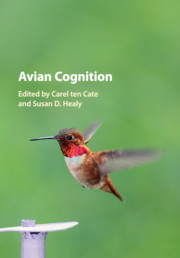Book contents
- Avian Cognition
- Avian Cognition
- Copyright page
- Contents
- Contributors
- Preface
- 1 Introduction: Avian Cognition – Why and What?
- 2 Spatial Cognition in Birds
- 3 Spatial Cognition and Ecology: Hummingbirds as a Case Study
- 4 Food Storing and Memory
- 5 Avian Cognition and the Evolution of Warning Signals
- 6 Social Learning and Innovation
- 7 Solving Foraging Problems: Top-Down and Bottom-Up Perspectives on the Role of Cognition
- 8 Objects and Space in an Avian Brain
- 9 Physical Cognition and Tool Use in Birds
- 10 Avian Numerical Cognition: A Review and Brief Comparisons to Non-Avian Species
- 11 Mechanisms of Perceptual Categorization in Birds
- 12 Relational Concept Learning in Birds
- 13 The Linguistic Abilities of Birds
- 14 Avian Vocal Perception: Bioacoustics and Perceptual Mechanisms
- 15 Sing Me Something Smart: Does Song Signal Cognition?
- 16 Avian Social Relations, Social Cognition and Cooperation
- Index
- References
11 - Mechanisms of Perceptual Categorization in Birds
Published online by Cambridge University Press: 22 June 2017
- Avian Cognition
- Avian Cognition
- Copyright page
- Contents
- Contributors
- Preface
- 1 Introduction: Avian Cognition – Why and What?
- 2 Spatial Cognition in Birds
- 3 Spatial Cognition and Ecology: Hummingbirds as a Case Study
- 4 Food Storing and Memory
- 5 Avian Cognition and the Evolution of Warning Signals
- 6 Social Learning and Innovation
- 7 Solving Foraging Problems: Top-Down and Bottom-Up Perspectives on the Role of Cognition
- 8 Objects and Space in an Avian Brain
- 9 Physical Cognition and Tool Use in Birds
- 10 Avian Numerical Cognition: A Review and Brief Comparisons to Non-Avian Species
- 11 Mechanisms of Perceptual Categorization in Birds
- 12 Relational Concept Learning in Birds
- 13 The Linguistic Abilities of Birds
- 14 Avian Vocal Perception: Bioacoustics and Perceptual Mechanisms
- 15 Sing Me Something Smart: Does Song Signal Cognition?
- 16 Avian Social Relations, Social Cognition and Cooperation
- Index
- References
- Type
- Chapter
- Information
- Avian Cognition , pp. 208 - 228Publisher: Cambridge University PressPrint publication year: 2017
References
- 3
- Cited by

